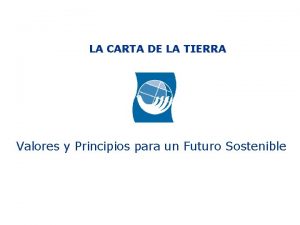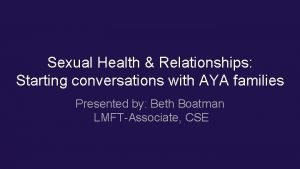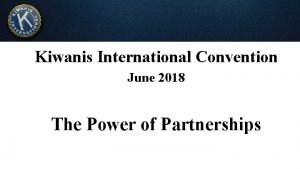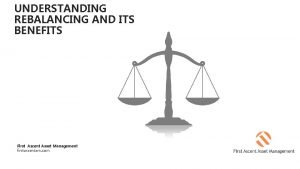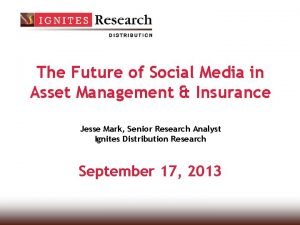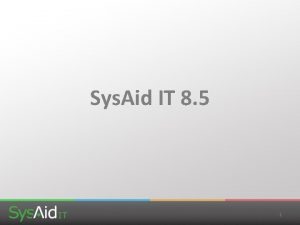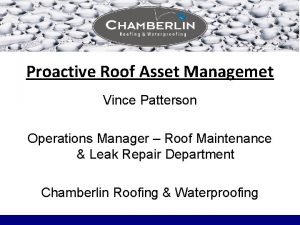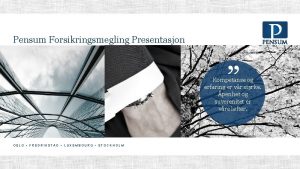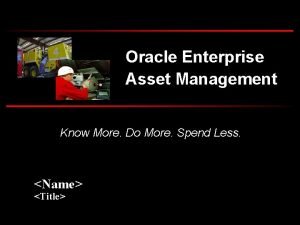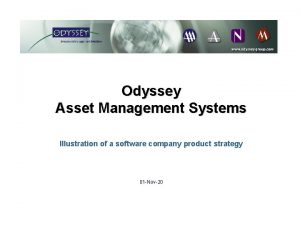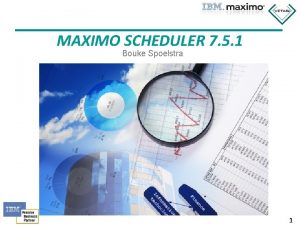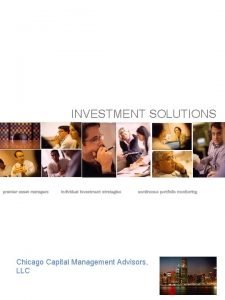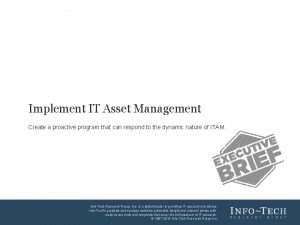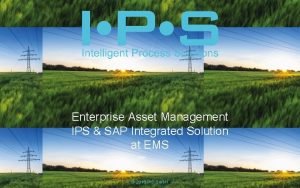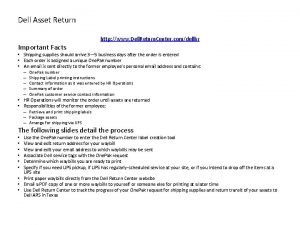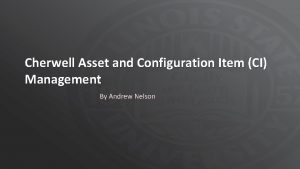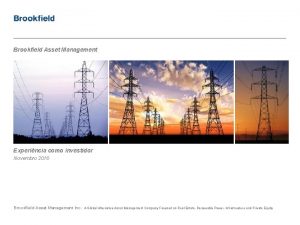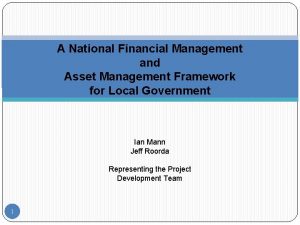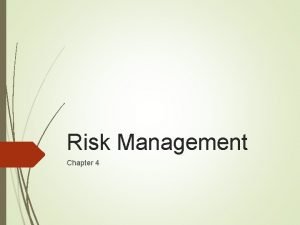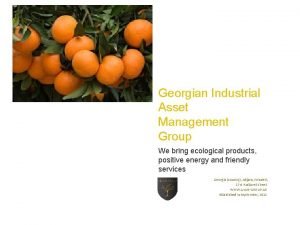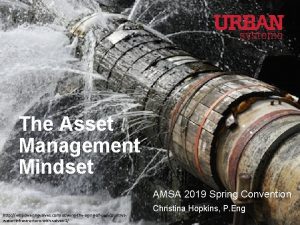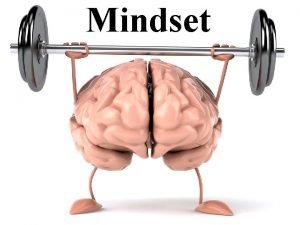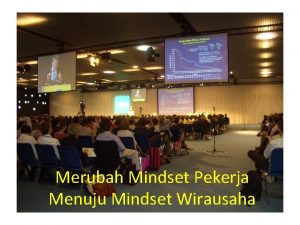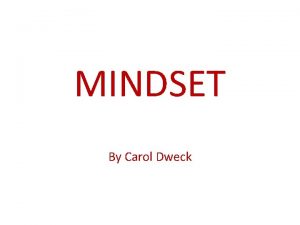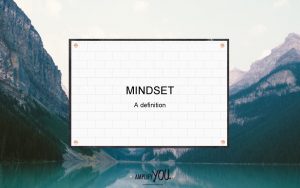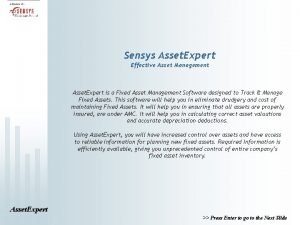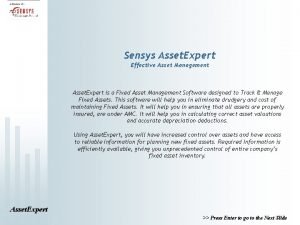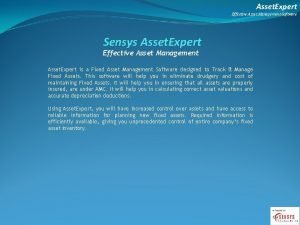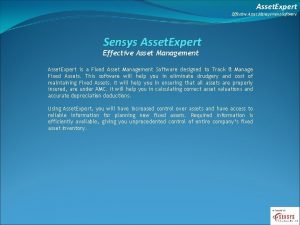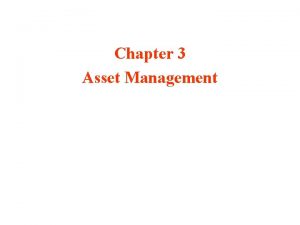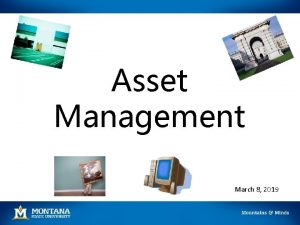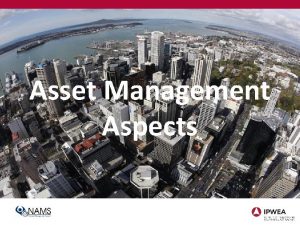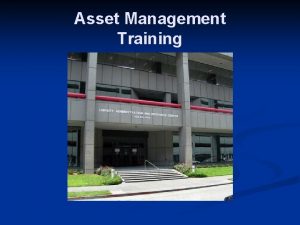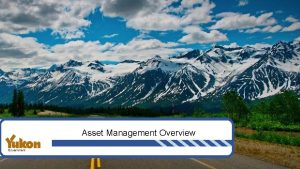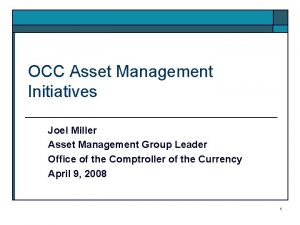The Asset Management Mindset AMSA 2019 Spring Convention






























- Slides: 30

The Asset Management Mindset AMSA 2019 Spring Convention http: //empoweringvalves. com/slowing-the-aging-of-our-countryswater-infrastructure-with-valves-2/ Christina Hopkins, P. Eng

You’re thinking about buying a new truck. Current truck: • 2011 Ford F 150 with 175, 000 km • Used mostly to drive to work, and occasionally driving out to the mountains with a trailer (this is not your work truck!) • Some unexpected maintenance issues, but overall not bad What if you knew that in 6 months, your engine needs to be replaced? What if you knew that in 2 years, you are going to retire to Arizona?

What is Asset Management? Asset management is the process of making decisions about the use and care of infrastructure to deliver services in a way that considers current and future needs, manages risks and opportunities, and makes the best use of resources. Asset Management Handbook & Toolkit for Alberta Municipalities

Asset Management Mythbusting Asset management IS NOT Asset management IS A project or a single plan A process Capital asset accounting A forward looking practice An end itself A means to an end About counting assets and doing condition assessments About making good and informed decisions About calculating infrastructure deficits that seem too big to do anything about About taking action to make our communities more sustainable and resilient Just about replacing assets About making better decisions about assets and service delivery

Asset Management Mythbusting We don’t do asset management. We are all participating in asset management every day using our human capacity to make decisions. We are doing asset management because we have an asset management software. Software is a great tool – but by itself it is not asset management. Asset management should be done by Accounting. Asset management is a team sport, and works best when all departments are involved.

The Asset Management Mindset • It’s all about the services • Asset management is a means to an end • Asset management requires participation from the whole organization • Asset management concepts are scalable in complexity • Begin where you are • Strive for continuous improvement • Be adaptive!

Why should we do Asset Management? • It’s the right thing to do! • Ensures an adaptive approach to service delivery by considering current and future needs • Provides a defendable way of prioritizing projects and resources • Demonstrates accountability to the community • Aligns the organization to focus on the things that matter the most

Key Components of Asset Management Building Community Resilience Through Asset Management: A Handbook & Toolkit for Alberta Municipalities

Understanding Service • What services do you actually provide? • Who are you providing those services to? • What is your current level of service? • What is the desired level of service? • Customer expectations vs. technical reality Building Community Resilience Through Asset Management: A Handbook & Toolkit for Alberta Municipalities

Benefits of Understanding Service • The customer knows what to expect and what they are paying for • Knowing what the community is asking for can help with figuring out what you can afford • Risks and investment / cost cutting can be evaluated based on their impact on services • Knowing where you are and where you need to be makes it easy to identify gaps

Understanding Risk = Impact x Likelihood Impact: how severe are the consequences? Likelihood: how probable is it that this will happen? Two kinds of risk: • Asset Risk • Strategic Risk Building Community Resilience Through Asset Management: A Handbook & Toolkit for Alberta Municipalities

Strategic Risk Events or occurrences that impact your ability to achieve objectives. Examples of strategic risks include: • Possibility of reduced revenue • Dramatic increase in service demands • Changing demographics • Retiring workforce • Loss of critical data or information • Increases in infrastructure responsibility, no increase in operations & maintenance budgets

Asset Risk Events where an asset fails to perform as you need it to. Examples of asset risks: • A broken water pipe • A potholed road surface • Unplanned closure of your arena due to HVAC failure

Benefits of Understanding Risk • Develops a consistent language across the organization • Helps you to identify top priorities • Better allocation of limited financial and human resources • Helps all parts of your organization to agree on acceptable level of risk and mitigation activities • Contributes to building resilience in your community

Important Notes About Risk RISK TOLERANCE: • Risks cannot be entirely eliminated • Mitigating risks can be expensive • You may decide that some risks should just be tolerated – that’s ok! • All stakeholders should be informed of the decision RISK MITIGATION: • Capital projects or operational approaches can form a mitigation plan • A single project will only reduce the likelihood of the event or the impact of the event – but not both • You may need more than one approach to managing bigger risks

Understanding Costs & Funding Cost is defined as the financial and human resources required throughout the lifecycle of the asset. • Replacement costs of current assets • Capital costs of new assets • Current and projected O&M costs • Revenue sources for funding future capital and operational costs

Benefits of Understanding Lifecycle Costs and Funding • Identifies actions for minimizing lifecycle costs and maximizing value for your money • Identifies regular maintenance options to extend the life of the asset • Helps you make decisions about rate increases or decreases • Helps you figure out how much should be contributed to reserves and how reserves should be managed

Evaluating Trade-offs and Making Good Decisions • Service, risk and cost cannot be fully understood in isolation • Good decisions are informed with an understanding of service, risk and cost trade-offs that is appropriately accurate and complete • Service and risk trade-offs • Service and costs/funding trade-offs • Risk and costs/funding trade-offs Building Community Resilience Through Asset Management: A Handbook & Toolkit for Alberta Municipalities

Collecting Information • Information gathering and management is an ongoing process • Information doesn’t need to be perfectly accurate – it depends on what you need it for • Start with anecdotal data or estimates if that’s all you have (qualitative data is still data!) • Update and improve data over time Building Community Resilience Through Asset Management: A Handbook & Toolkit for Alberta Municipalities

Collecting Information • Identify where infrastructure is located • Record asset age, material, location, maintenance history, etc. • Respond to new development opportunities • Shared across multiple devices • Facilitate decision making and the management of community assets

• Implements Council direction and AM vision • Develops and implements AM processes • Supports Council by providing information for use in trade-off decisions Public • Champions of AM • Leadership through strategic direction • Use AM mindset to make tradeoff decisions • Are the link to the public Administration & Staff Council Roles In Asset Management • Users of services • Pays rates and taxes • Provides feedback and information to Council (and sometimes staff)

Public Works and Asset Management Develop and implement AM processes - Asset inventory management - Lifecycle cost – O&M too! - Customer level of service and technical level of service Provide information for use in trade-off decisions - “X km of sanitary pipe is in poor condition, but are good candidates for pipe relining” - “Our water system has X km of water pipe that is more than 50 years old, and has a higher likelihood of failure” - “The changes we made to our grass cutting level of service have saved us $X in the last year. ”

I’m in! Where do I start? There are so many places to choose from… AM Strategy AM AM Cou AM Policy rses Lea de. Framework AM Plan AM ship Tra inin AM g Out s A M S oftware n io t l a c li i p p A n t n a r G e AM AM C ertific ataiopn m d a o R AM

I’m in! Where do I start? Start where you are! Remember: asset management is a process. You won’t get it 100% right the first time. Starting with easily achievable, high value activities is a great way to start with success. • Information collection? • Database development? • Talk to your neighbours?

One way to talk to neighbours about rural roads:


Implementation Challenges Asset management takes time, effort and commitment. Asset management requires a certain amount of organizational change management. Organizational turnover causes delays. Successful implementation hinges on continuous communication of information and decisions.

Success is possible. First – establish an asset management team. Set realistic expectations for timeframe for change and the effort required. Document everything! Talk to your neighbours and colleagues. You don’t need to start from scratch.

Asset Management Mindset Checklist q Do we have the information we need to make a decision? q Have trade-offs between cost, risk, and service been considered? q Are we focusing on service delivery? q What are the long-term implications? q Have all the relevant disciplines been properly engaged in this decision (e. g. , planning, engineering, public works, finance, etc. )? q Are we thinking about both short- and long-term needs?

Questions? Christina Hopkins, chopkins@urbansystems. ca 780 -430 -4041 Building Community Resilience Through Asset Management: A Handbook & Toolkit for Alberta Municipalities
 La carta de la tierra
La carta de la tierra Amy tishelman
Amy tishelman Empleo amsa
Empleo amsa Primerica convention 2015
Primerica convention 2015 Kiwanis international convention 2019
Kiwanis international convention 2019 Spring summer fall winter and spring cast
Spring summer fall winter and spring cast Spring and autumn months
Spring and autumn months Asset management vs project management
Asset management vs project management Ascent
Ascent Maximo dynamic job plans
Maximo dynamic job plans Asset management companies using social media
Asset management companies using social media Unity datatable
Unity datatable Sysaid it asset management
Sysaid it asset management Roof asset management software
Roof asset management software Pensum forsikringsmegling
Pensum forsikringsmegling Oracle enterprise asset management software
Oracle enterprise asset management software Triple a portfolio management software
Triple a portfolio management software Maximo job scheduling
Maximo job scheduling Premier asset management vision
Premier asset management vision It asset management sop
It asset management sop Ips sap
Ips sap Dell return center
Dell return center Cherwell inventory management
Cherwell inventory management Who owns brookfield asset management
Who owns brookfield asset management Automate asset management
Automate asset management National asset management assessment framework
National asset management assessment framework Software asset management microsoft
Software asset management microsoft Ranked vulnerability risk worksheet
Ranked vulnerability risk worksheet Infrastructure and asset management
Infrastructure and asset management Lawrence park credit strategies
Lawrence park credit strategies Industrial asset management llc
Industrial asset management llc
